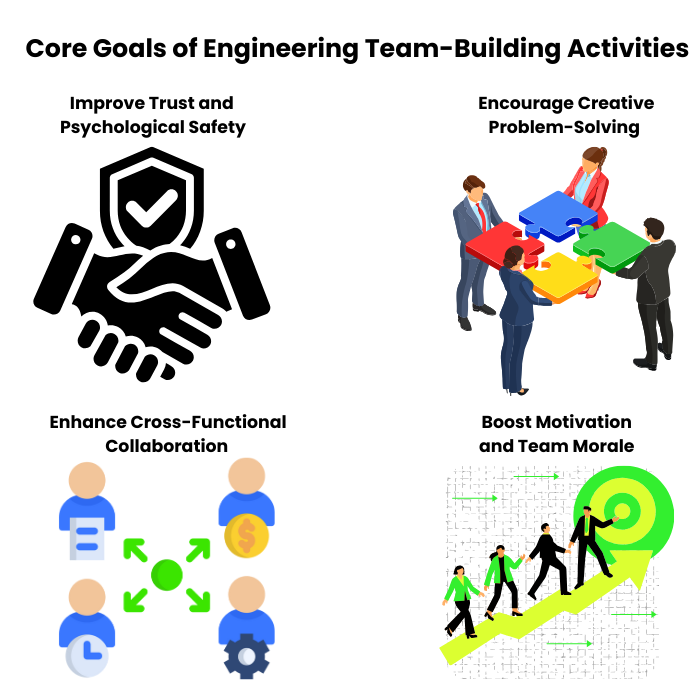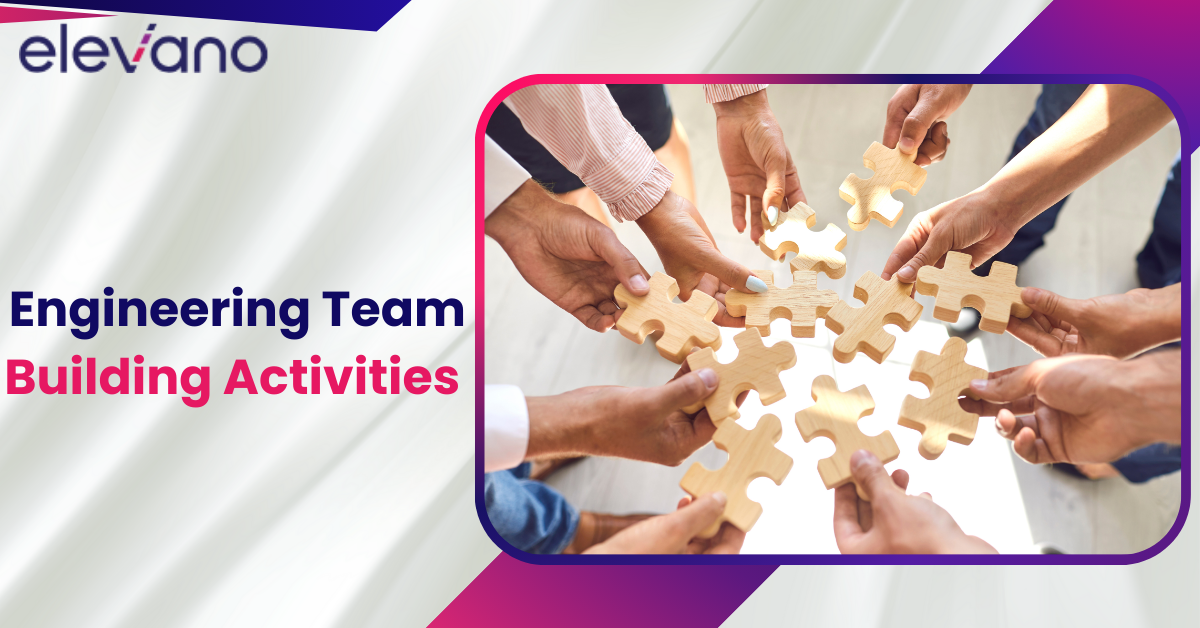Great engineering teams don’t just happen—they’re built through smart collaboration, clear communication, and mutual respect. But with deadlines, code reviews, and backlogs, team bonding often takes a backseat.
That’s a mistake. When engineers trust each other, they ship faster, solve harder problems, and enjoy the work more.
This guide isn’t about trust falls or cheesy games. It’s about real team building—activities that fit how engineers think, work, and grow together.
So read on—we’re breaking down the best ways to build stronger, more connected engineering teams without wasting anyone’s time.
Why Engineering Teams Need Specialized Team Building
Engineering teams don’t work in isolation. Developers, testers, product managers, and designers rely on each other to ship quickly and well. That level of dependency means misalignment can slow everything down.
They also work in a high-focus environment. Problem-solving, debugging, and deep work demand long stretches of mental focus and autonomy. Add in meetings, reviews, and handoffs, and it’s easy for collaboration to feel like friction.
And in many teams today, some engineers are in the office, while others are remote. Without effort, that gap creates uneven communication, weak bonds, and missed context.
Common Challenges in Engineering Culture
Many engineers never get training in soft skills—communication, feedback, or conflict resolution. They’re expected to figure it out on the fly.
There’s also a culture of “just get it done.” Projects take priority, and team relationships often come second. That might work short-term, but over time it leads to burnout, silos, and lack of trust.
Remote and hybrid setups make it harder. Messages get missed. People feel left out. And when that happens, team performance suffers—quietly, but consistently.
That’s why thoughtful, relevant team building matters. Not cheesy games, but activities that strengthen how engineers work together day to day.
Core Goals of Effective Engineering Team Building Activities

Team building isn’t just a break from the backlog—it’s a way to solve real problems inside the team. When done right, it strengthens the foundation for better work, fewer blockers, and faster delivery.
Improve Trust and Psychological Safety
Engineers need to feel safe asking questions, sharing unfinished ideas, and admitting mistakes. Without that, feedback gets filtered, risks are avoided, and innovation slows. Team building creates space for open, honest connection—something no sprint retrospective can fake.
Enhance Cross-Functional Collaboration
Engineering teams aren’t just coders. They include QA, DevOps, product managers, and sometimes even designers or analysts. Good team-building activities help these roles understand each other’s work and communicate more effectively when it counts. These activities foster collaboration and create a sense of shared purpose among team members, ultimately leading to improved project outcomes. By understanding each other’s strengths and challenges, teams can better allocate resources and adapt to changing demands. Therefore, investing time in building effective engineering teams is essential for achieving both innovation and efficiency. In addition to fostering collaboration, understanding the ideal data engineering team roles can significantly enhance the effectiveness of project execution. By clearly defining responsibilities among data engineers, data scientists, and analytics professionals, teams can leverage individual expertise to drive smarter decision-making. This structured approach not only improves workflow but also fosters an environment where innovation can thrive.
Encourage Creative Problem-Solving
Stepping away from day-to-day tasks gives engineers a chance to approach problems differently. Activities that mix logic, creativity, and teamwork often reveal new ways to think—and help engineers flex skills they don’t use in Jira tickets.
Boost Motivation and Team Morale
Working through bugs and tight deadlines can wear people down. Team building adds energy, breaks monotony, and reminds everyone they’re part of something bigger than just tasks and tickets.
Strengthen Alignment with Company and Team Goals
When people understand each other better, they align faster on what matters. That means fewer miscommunications, faster decisions, and teams that move in sync with leadership goals
Criteria for Choosing the Right Activities
Not every team-building activity works for engineering teams. Some feel forced. Others just waste time. The good ones connect with how engineers think, how they work, and what they actually care about. Effective activities should foster collaboration, spark creativity, and align with the technical challenges engineers face daily. Engaging in hands-on problem-solving exercises can help to forge stronger connections and enhance communication within the group. Ultimately, investing the time in thoughtful team-building experiences plays a crucial role in building highperforming tech teams.
What Makes an Activity Effective for Engineers?
- It fits how the team works
If the activity helps build habits used in daily standups, code reviews, or problem-solving, it’s worth doing. Relevance matters. Engineers are quick to spot busywork. - It blends logic with creativity
The best activities let people think, build, or solve something together—not just answer icebreaker questions. Give them puzzles, challenges, or low-stakes experiments that use both brainpower and imagination. - It pushes the team gently outside their comfort zones
Growth happens when people try something new—but not so far out that it feels awkward or pointless. A little stretch is good. Too much kills buy-in. - It’s fun without being cheesy
Engineers value authenticity. Don’t force energy. The goal isn’t loud laughs—it’s meaningful interaction and better team dynamics.
Customization Tips
- Match it to your team setup
A distributed team has different needs than one in the same office. Remote-friendly tools matter. So does timing across time zones. - Let the team help choose
Ask what they’d enjoy—or better yet, rotate ownership of activities. When engineers help pick or run things, they’re more likely to show up and engage.
So read on—we’re about to break down activities that actually work and why they land so well with technical teams.
Activity Ideas for Engineering Teams (Categorized by Goal)
Not every team-building activity works for engineers—but the right ones can shift how your team thinks, builds, and communicates. Below are real examples that actually connect with how engineering teams work.
Problem-Solving & Innovation Focused
1. Hackathons and Innovation Jams
Set a timer, pick a challenge, and let small teams build fast. It could be a new feature, a bug fix, or even a passion project. The goal isn’t polish—it’s creativity, fast thinking, and fresh ideas.
To shake things up, pair engineers who don’t normally work together. It helps break silos and sparks new perspectives.
2. Reverse Engineering Challenges
Give the team an old tool, internal script, or open-source project and ask: How can we make this better?
It’s great for sharpening problem-solving skills and encourages curiosity about how things work behind the scenes.
3. Escape Room (Physical or Virtual)
Whether you’re in-person or remote, escape rooms challenge teams to solve problems under pressure. These games force clear communication, quick thinking, and shared focus—exactly what great teams need.
Communication & Collaboration Boosters
4. Pair Programming Swaps
Rotate programming pairs each week. It spreads knowledge, uncovers hidden blockers, and helps juniors learn from seniors—without formal training.
It’s low-cost, ongoing, and builds natural trust.
5. Design Debates
Pick a technical decision the team recently made—or will soon—and have a debate. One side defends, the other challenges. It sharpens communication and helps teams explain their thinking instead of just pushing code.
6. Agile Retrospective with a Twist
Retros don’t have to be boring. Add themed games, storytelling rounds, or light awards like “Best Debug Save” or “Smoothest Merge.”
It keeps things fresh and encourages open, honest feedback without turning it into a complaint session.
Trust & Psychological Safety Builders
7. Engineer’s Hot Seat (Non-Technical)
Take five minutes during standup or lunch and let one team member answer fun, personal questions—favorite book, proudest moment, most-used app.
It’s casual, fast, and builds connection without forcing vulnerability.
8. Feedback Circles
Once a month, the team gathers to give short, direct appreciation or feedback to peers—verbally or anonymously. Keep it structured and short.
Done right, it normalizes honest conversations and strengthens respect across roles.
9. Blind Code Review
Strip names from a pull request, then have the team review it together. It reduces bias and creates space for more honest, idea-focused feedback.
Plus, it sharpens review skills across the board.
Fun & Culture-Focused Activities
10. “Demo Day” Show & Tell
Give team members a chance to share personal or side projects—anything from an Arduino build to a custom keyboard. It brings out hidden skills and encourages appreciation beyond work tasks.
11. Engineering Memes Contest
Let the team submit and vote on funny, relatable memes about bugs, builds, or sprint life. Winner gets bragging rights or a small prize.
It’s silly, simple, and gives everyone a quick laugh break.
12. Monthly Game Night (Board or Digital)
Pick a game that needs teamwork—virtual escape rooms, trivia, or something chaotic like Keep Talking and Nobody Explodes.
It’s an easy way to unwind, especially for remote teams, without needing small talk.
How Can Engineering Team Building Activities Enhance Leadership Skills?
Engaging in team-building activities can significantly enhance leadership skills within engineering teams. These exercises foster collaboration, communication, and adaptability. By embracing challenges together, team members learn critical problem-solving skills. Incorporating these activities into professional development offers valuable tips for engineering leadership, ultimately creating stronger, more effective leaders in the workplace.
Team Building for Remote or Hybrid Engineering Teams

Remote work isn’t going anywhere—and that means team building needs to adapt. Distributed teams face extra friction: missed cues, uneven engagement, and limited casual interaction.
Tools That Make It Work
Use platforms your team already knows—Slack, Zoom, Miro, Gather, or Notion. Keep the setup simple. Avoid tech-heavy games that drain more energy than they give back.
Tips for Remote-Friendly Activities
- Short and sharp beats long and awkward. Keep sessions under 60 minutes.
- Mix async and live. Let folks contribute memes or feedback on their schedule.
- Don’t force video. Give people the option to join by voice or chat.
- Be timezone-aware. Rotate meeting times so no one’s always stuck with early or late hours.
How to Measure the Success of Team Building Activities
You can’t improve what you don’t track. Great team-building isn’t just about laughs—it should show up in how your team communicates, delivers, and engages.
What to Look For
- Team sentiment. Use quick pulse surveys or anonymous forms to ask, “Did this help?” or “Would you do it again?”
- Engagement levels. Are people showing up? Are they participating without being pushed?
- Sprint metrics. Look for fewer blockers, smoother handoffs, or improved velocity over time.
- Quality of conversations. Listen for more open feedback, faster decisions, or stronger collaboration in meetings.
Let me explain—these results don’t happen overnight. But if the vibe improves and blockers drop, you’re on the right track.
Final Thoughts
Engineering team building doesn’t have to be awkward, forced, or time-wasting. When done right, it helps teams move faster, think better, and enjoy the work more.
Start small. Pick one activity that fits your team’s vibe, test it, and build from there. Over time, these small efforts create real momentum—better sprints, stronger relationships, and fewer blockers.
Because in the end, great teams aren’t built by chance. They’re built on purpose.




